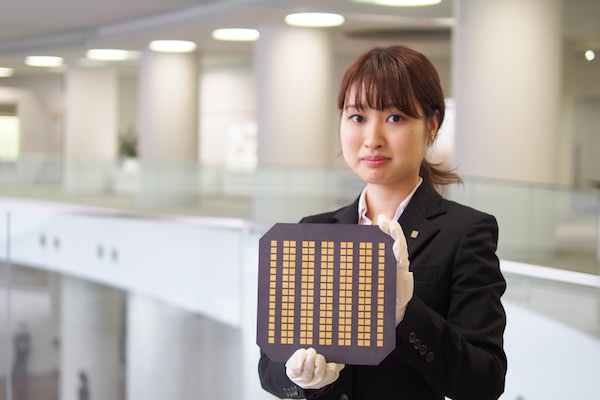
[Image above] At the Kyocera headquarters in Kyoto, Japan, a staff member holds a multilayer cofired ceramic substrate for use in probe cards to test memory devices on 300 mm silicon wafers. She stands in front of a large fine ceramics museum located in the lobby of Kyocera headquarters. Credit: Kyocera
The April 2018 issue of the ACerS Bulletin is now available online.
The cover story this month goes deep into a pervasive, yet often overlooked, role for ceramics in a huge global market—the semiconductor industry. Written by Kyocera International’s Arne Knudsen, the article details how ceramics enable developments in the electronics industry through their essential role in the manufacturing, use, and application of advanced semiconductors. Ceramics’ properties make them ideal materials for semiconductor manufacturing and packaging applications, such as transporting wafers, protecting medical devices, supporting enhanced communications, and protecting satellite electronics. Read on to learn more about the varied and vast roles of our favorite materials in this huge industry.
The new issue also features an article that details an innovative new way to look at energy storage—using an ancient technology. By using refractory materials called firebricks, authors Charles Forsberg, Daniel C. Stack, Daniel Curtis, Geoffrey Haratyk, and Nestor Andres Sepulveda detail a way to convert excess low-priced electricity into high-temperature stored heat. This strategy can limit electricity price collapse from high wind and solar output, by using the firebrick to store that low-price electricity at times when demand is low. Heated firebrick can then provide hot air as needed to industrial furnaces, kilns, power plants, and gas turbines. It’s a low-tech solution with high potential to help address varied energy needs.
Plus, the April issue also features a case study by ITC Coatings’ Greg Odenthal that shows how ceramic furnace coatings can offer significant benefits to manufacturers. That’s because these high-temperature ceramic coatings for furnace-lining refractories can simultaneously reduce energy consumption, improve temperature uniformity, reduce furnace maintenance, and increase production—offering incredible potential benefits. In one instance, the coatings were able to add the potential for $480,000 of additional annual revenue for one company.
And be sure not to miss Mike O’Driscoll’s IMFORMED insights column this month, where he provides his expert industrial minerals knowledge on how proppant demand is influencing ceramic mineral supply. The sands are changing, with proppant demand again increasing after a recent dip—but is there enough material to continue to supply proppant materials’ other markets, including glass, ceramic, and foundry applications?
The April issue is also special because it’s the one we will be showcasing at Ceramics Expo 2018, May 1–3 in Cleveland, Ohio. This one-stop expo and conference for all things in the ceramics and glass material supply chain is completely free to attend, so if you haven’t yet registered, click here to sign up. And flip to page 52 of the new issue to find out how the ever-popular additive manufacturing will be present on the exhibit floor, innovation trails, and conference at Ceramics Expo 2018.
There’s lots more good stuff inside this—and every issue—of the ACerS Bulletin. The current issue is free to all for a short time, but remember that all the valuable content in over ninety years of past issues of the ACerS Bulletin is free only to members—so considering joining us today!
Did you find this article interesting? Subscribe to the Ceramic Tech Today newsletter to continue to read more articles about the latest news in the ceramic and glass industry! Visit this link to get started.

